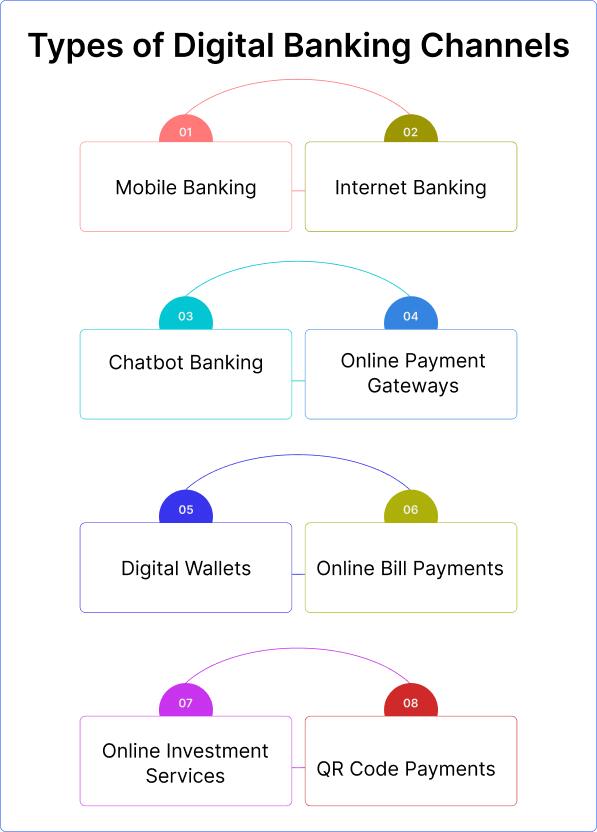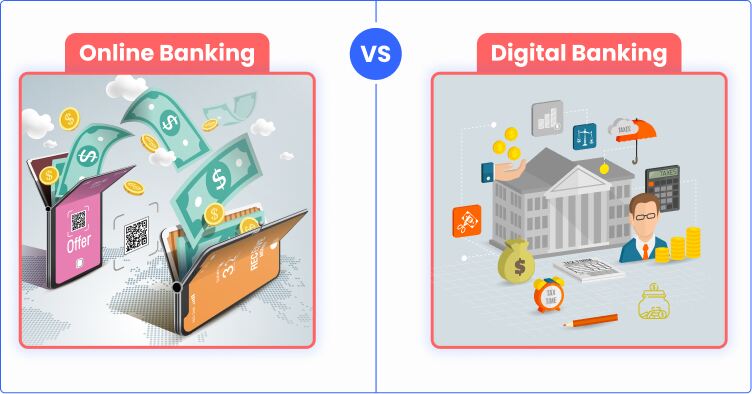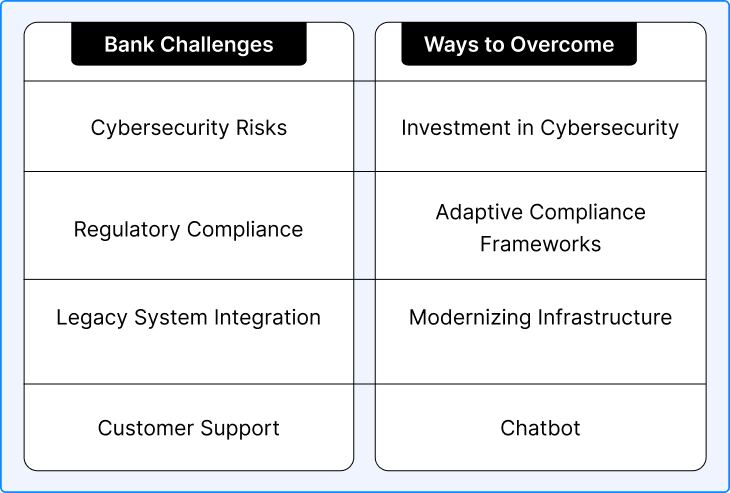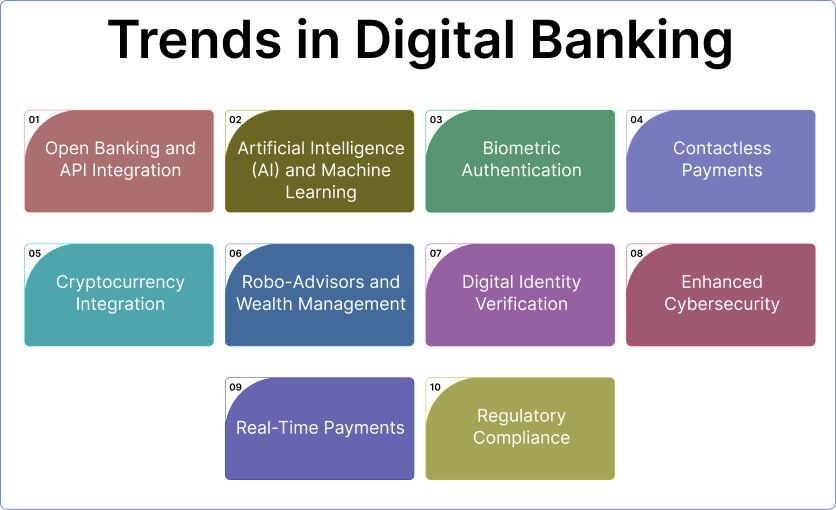Bangladesh is surging ahead in the finance realm to embrace digital banking at an astounding pace. Just think of a place for a minute where banking is as effortless as a text message. You can access savings, make payments, and invest, all with a few taps on your smartphone.
Bangladesh aims for 75% of local transactions to go digital by 2027, as a vision of a “Smart Bangladesh” by 2041. Notably, Nagad Digital Bank and Kori Digital have recently joined as newly licensed digital banks to start a new beginning.
In this exploration of Bangladesh’s digital banking landscape, we uncover the fusion of convenience and innovation, where the future of finance rests within arm’s reach. So, get ready to be amazed as we’re taking you to this fintech revolution propelling Bangladesh forward!
What is Digital Banking?
Digital banking refers to the use of digital technology and online channels to provide a wide range of financial services to customers. Unlike traditional banking, digital banking operates in a branchless and virtual environment. The primary objective of digital banking is to enhance accessibility, convenience, and efficiency for users. It eliminates the need for physical branches and allows transactions and interactions through electronic means.
Additionally, digital banking has further evolved with the emergence of Neo-Banking. Neo-banks, or digital-only banks, operate exclusively online without physical branches. They leverage technology to provide innovative and user-centric financial solutions. The integration of Neo-Banking concepts aligns with the broader trend of using technology to transcend geographical limitations and time constraints to the evolving needs of a digitally connected society.
In digital banking, customers can access their accounts, conduct transactions, and manage their finances through secure online interfaces. Furthermore, it facilitates electronic payments and transfers that reduce reliance on physical currency. It often incorporates advanced security measures such as encryption, multi-factor authentication, and continuous monitoring to ensure the safety of customer information and prevent unauthorized access.
Digital Transformation Over Time in Banking
Digital transformation in banking has been an ongoing journey that has evolved significantly over time. The financial industry has seen a remarkable shift from traditional banking methods to fully embracing digital technologies.
Here’s a timeline that highlights key developments in the digital transformation of banking:
1960s – 1980s: Early Automation
- Banks began to automate their processes with the introduction of electronic data processing systems.
- ATMs (Automated Teller Machines) were introduced, allowing customers to perform basic transactions outside of bank branches.
1990s: Online Banking
- Banks launched online banking services, providing customers with the ability to check balances, transfer funds, and pay bills over the Internet.
- The adoption of secure socket layer (SSL) encryption made online banking safer.
2000s: Mobile Banking and SMS Alerts
- The proliferation of mobile phones led to the introduction of mobile banking services.
- SMS alerts were used to notify customers about account activity and transactions.
- Online payment gateways like PayPal gained popularity.
2010s: Fintech Disruption
- The rise of fintech startups challenged traditional banks to offer innovative solutions for payments, lending, and personal finance management.
- Mobile banking apps evolved, providing features like mobile check deposits, P2P payments, and budget tracking.
- Regulatory changes, like PSD2 in Europe, encouraged open banking and data sharing between banks and third-party providers.
The mid-2010s: Blockchain and Cryptocurrency
- The emergence of blockchain technology and cryptocurrencies like Bitcoin created new avenues for financial transactions, particularly in the areas of cross-border payments and remittances.
- Central banks explored the potential for central bank digital currencies (CBDCs) as digital counterparts to physical currency.
Late 2010s – Early 2020s: AI and Automation
- Artificial intelligence (AI) and machine learning were integrated into banking systems for customer service, fraud detection, and risk assessment.
- Robo-advisors gained traction, offering automated investment advice.
- Chatbots and virtual assistants have become common in customer support.
Present and Beyond Omnichannel Banking and Personalization
- Banks are moving towards providing a seamless omnichannel experience, where customers can transition between online, mobile, and physical channels seamlessly.
- Many tech-driven banks are using Chatbots to provide a consistent experience across different channels to ensure that customers receive uniform information and assistance whether they are interacting through a website, mobile app, or other channels.
- Personalization is a key focus, with banks using data analytics to offer tailored financial products and services.
- Enhanced cybersecurity measures, including biometrics and multi-factor authentication, are being adopted to protect digital assets.
- Quantum computing and 5G technology may further revolutionize the banking industry by enabling faster data processing and more secure transactions.
- Decentralized finance (DeFi) and blockchain-based financial services could become more mainstream, potentially reshaping the industry’s infrastructure.
The digital transformation in banking continues to evolve, driven by rapid advancements in technology and changing customer expectations. As banks adapt to these changes, they are likely to remain at the forefront of innovation to offer increasingly convenient and secure financial services.
Types of Digital Banking Channels
1. Mobile Banking
It allows customers to access their bank accounts and conduct financial transactions using a mobile device, typically through a dedicated banking app or mobile web browser. It offers features like checking balances, transferring funds, bill payments, and mobile deposits.
2. Internet Banking
It also known as online banking enables customers to access their bank accounts and perform transactions through a web portal using a desktop or laptop computer. It provides services such as account management, bill payments, and fund transfers.
3. Chatbot Banking
Chatbot banking brings convenience and accessibility to the financial landscape. This innovative technology employs artificial intelligence to enable meaningful interactions between customers and their banks through natural language conversations. It simplifies financial tasks, offering 24/7 assistance for inquiries, transactions, and personalized financial advice, all via a chat interface. Chatbot is revolutionizing traditional banking by providing instant, personalized support and fostering a more intuitive and user-friendly banking environment.
4. Online Payment Gateways
These gateways are digital platforms that facilitate secure online transactions. They are commonly used for e-commerce and allow customers to make purchases or payments electronically.
5. Digital Wallets
It is also known as e-wallets are mobile apps or online platforms that allow users to store and manage their payment information, such as credit card details and bank account information. They enable quick and secure payments for a wide range of transactions, both online and in physical stores.
6. Online Bill Payments
Online fund transfer services allow users to send money to individuals or businesses electronically. These services include peer-to-peer (P2P) payment platforms, wire transfers, and interbank transfers. They offer a convenient and efficient way to move money between accounts.
7. Online Investment Services
It also known as robo-advisors or online brokerage platforms, provides individuals with the ability to invest in stocks, bonds, mutual funds, and other financial instruments online. They often use algorithms to offer investment advice and portfolio management services.
8. QR Code Payments
It involves scanning a Quick Response (QR) code with a mobile device to initiate a payment. This technology is commonly used for in-store and person-to-person (P2P) transactions, making payments swift and contactless.
Digital Banking Vs Online Banking: Key Differences
Both are closely related terms but have distinct differences in terms of scope and functionality:
1. Scope of Services
- Online Banking: It typically refers to digital access to your customer’s existing bank account through a web portal or a mobile app. It allows your customers to perform basic banking operations like checking account balances, transferring funds, and paying bills online.
- Digital Banking: It encompasses a broader range of financial services. It often includes not just basic banking functions but also more advanced services like investment management, budgeting tools, and even the ability to open new accounts online. It’s a comprehensive, all-in-one financial platform.
2. Access Points
- Online Banking: It is primarily accessed through a bank’s website via a web browser or a dedicated online banking app. It’s essentially an electronic version of traditional banking services.
- Digital Banking: It can include online banking but extends beyond it. It can encompass multiple channels, such as mobile apps, dedicated banking apps, fintech apps, or even integrated financial management platforms.
3. Interconnected Services
- Online Banking: It focuses on the core banking services offered by a specific bank or financial institution. It doesn’t necessarily integrate seamlessly with other non-banking financial services.
- Digital Banking: It integrates with a broader ecosystem of financial tools and services. It may provide access to third-party financial apps, investment platforms, and personal finance management tools to create a more holistic financial experience.
4. Customer-Centric Approach
- Online Banking: It is essentially a web-based version of traditional banking to offer convenience and 24/7 access to basic banking services. However, it may not always prioritize customer-centric innovations.
- Digital Banking: It is designed with a strong customer-centric approach. It often incorporates user-friendly interfaces, personal financial insights, and customized financial solutions to emphasize a more personalized and modern user experience.
5. Innovation and Integration
- Online Banking: It may not always keep up with the latest fintech innovations and trends, and its services can be limited to what the specific bank offers.
- Digital Banking: It is more likely to adopt the latest technological innovations, including artificial intelligence, blockchain, and open banking principles. It’s often more adaptable to evolving customer needs and preferences.
While online banking is a subset of digital banking, the latter offers a more comprehensive and technologically advanced suite of financial services. Digital banking leverages technology to create a more holistic, customer-focused, and integrated financial experience, often involving a broader ecosystem of financial tools and services.
Digital Banking Challenges and Effective Ways to Overcome
Balancing convenience with concerns about security and technological accessibility can be a big challenge for the customer. On the flip side, navigating cybersecurity risks, regulatory compliance, and integrating digital innovations within existing systems pose hurdles for banks embracing digital transformations. Let’s take a deep look at the key challenges customers and banks may encounter.
Bank Challenges & Solutions:
1. Cybersecurity Risks: Banks encounter escalating threats of cyberattacks and data breaches. Banks must ensure robust security measures and ongoing investments in cybersecurity infrastructure.
Solution:
- Investment in Cybersecurity: Continual investment in advanced cybersecurity measures, including encryption technologies, threat detection systems, and regular security audits to safeguard against cyber threats.
2. Regulatory Compliance: Adhering to ever-evolving regulations and compliance standards in various jurisdictions poses a challenge. It requires continual adaptation and resources.
Solution:
- Adaptive Compliance Frameworks: Develop flexible and adaptive compliance strategies to navigate changing regulatory landscapes and ensure adherence to evolving standards.
3. Legacy System Integration: Introducing digital innovations into existing legacy systems can be complex and costly. It hinders the seamless integration of new technologies.
Solution:
- Modernizing Infrastructure: Gradually modernizing legacy systems to enable integration of digital innovations. It ensures they complement and enhance existing banking operations rather than disrupt them.
4. Customer Support: Offering effective customer support can be a big challenge in digital banking. It involves addressing the demands for automated query resolution, timely responsiveness, and maintaining a human touch in a virtual environment.
Solution:
- Chatbot: Using AI-powered Chatbots for quick query resolution, implementing a well-structured knowledge base, and combining automation with personalized human assistance can enhance the efficiency and effectiveness of customer support in digital banking.
Current Trends in Digital Banking
Several trends are shaping the landscape of digital banking. It’s important to note that the digital banking industry is dynamic, and new trends may have emerged since then.
Here are some of the current trends in digital banking up to that point:
1. Open Banking and API Integration
Open banking initiatives, such as PSD2 in Europe, have promoted data sharing between banks and third-party providers through APIs. This enables customers to access a broader range of financial services and manage multiple accounts from a single platform.
2. Artificial Intelligence (AI) and Machine Learning
Banks are using AI and machine learning for enhanced customer service, personalized product recommendations, fraud detection, and credit risk assessment. Chatbots and virtual assistants have become common in customer support.
3. Biometric Authentication
Enhanced security measures, such as biometric authentication (fingerprint, facial recognition, and voice recognition), are increasingly used for secure access to mobile banking apps and online accounts.
4. Contactless Payments
The adoption of contactless payment methods, including mobile wallets (Apple Pay, Google Pay) and contactless cards, has grown significantly, especially in response to the COVID-19 pandemic.
5. Cryptocurrency Integration
Some banks are exploring or integrating cryptocurrencies and blockchain technology, offering services like cryptocurrency custody and trading to meet the evolving demands of customers.
6. Robo-advisors and Wealth Management
It continues to gain traction, providing automated and algorithm-based investment advice to customers. These platforms make investing more accessible and affordable.
7. Digital Identity Verification
Digital banks and financial institutions are investing in advanced digital identity verification methods to streamline the onboarding process and comply with regulatory requirements, such as Know Your Customer (KYC) checks.
8. Enhanced Cybersecurity
With the increased digital footprint, cybersecurity remains a top priority. Banks are adopting advanced security measures, such as multi-factor authentication and AI-driven threat detection, to protect customer data and assets.
9. Real-Time Payments
Real-time payment systems are being adopted in many countries, allowing instant fund transfers and reducing the time and cost associated with transactions.
10. Regulatory Compliance
Compliance with evolving financial regulations, including data privacy laws like GDPR and consumer protection regulations, is a significant focus for digital banks.
Key Benefits and Impacts of Digital Banking
Digital banking benefits customers by offering convenience, cost savings, and personalization, while it benefits banks through cost reduction, increased customer reach, and data-driven insights, leading to improved customer engagement and competitiveness in the financial industry.
Customer Benefits:
- Convenience: Customers enjoy unparalleled convenience with 24/7 access to banking services from anywhere. It eliminates the need to visit physical branches. Transactions, account inquiries, and even financial advice are just a tap away on their smartphones or devices.
- Efficiency: Digital banks offer swift and seamless transactions. Tasks like fund transfers, bill payments, and account management take mere minutes. It reduces wait times and bureaucracy associated with traditional banking.
- Personalization: These banks often leverage data-driven insights to tailor services to individual customer needs. With personalized recommendations to targeted financial advice, customers experience a more customized and relevant banking experience.
- Lower Costs: Digital banks typically have fewer overhead expenses related to maintaining physical branches. As a result, they often offer lower fees, higher interest rates on savings, and better exchange rates, providing cost savings and better value to customers.
- Enhanced Security: Advanced security measures, such as biometric authentication and encryption technologies, ensure robust protection of customer data and transactions to foster trust and confidence among users.
Bank Benefits
- Scalability: Digital banks have the advantage of rapid scalability, as their operations are not tied to physical infrastructure. They can expand their services and customer base swiftly and cost-effectively to tap into a broader market without the constraints of brick-and-mortar limitations.
- Data Analytics: Access to vast amounts of data generated by customer interactions. They can leverage this data through analytics to gain insights into customer behavior, preferences, and trends. This information helps in refining services to create targeted marketing campaigns, and making data-driven business decisions.
- Agility and Innovation: Digital banks operate in an environment that fosters innovation and agility. They can quickly adapt to market changes, integrate new technologies, and roll out innovative services to stay ahead of the curve in meeting evolving customer demands.
- Reduced Operational Costs: Without the overheads of maintaining physical branches, digital banks can significantly reduce operational costs. This includes expenses related to property, staffing, and infrastructure maintenance. It allows them to allocate resources more efficiently.
- Accessibility and Inclusivity: It can reach underserved populations to provide banking services to those who have limited access to traditional banks. This inclusivity not only serves a societal purpose but also opens up new markets and revenue streams for the bank.
How is Bangladesh Adapting Digital Banking?
Bangladesh is undoubtedly making significant strides towards embracing digital banking. A total of 52 domestic and foreign entities have applied to the central bank for the license to set up digital banks. The Business Standard reports that the Bangladesh Bank made a decision to approve digital banking licenses to two of the 52 applicants, as confirmed by a senior official from the central bank.
The two newly licensed digital banks are Nagad Digital Bank and Kori Digital. The Bangladesh Bank has granted permission to three other applicants to establish digital banking services with the support of various traditional banks.
Furthermore, there are three more applicants, who have the backing of fintech firms and other companies, who may also be granted licenses after a thorough six-month evaluation period to assess the performance of the initial two digital banks.
However, the question of whether it is fully ready for this transformation involves several key considerations:
- Infrastructure: The readiness for digital banking in Bangladesh hinges on its technological infrastructure. While the country has seen an increase in mobile penetration and internet access, there is still room for improvement, especially in rural areas. A robust and widespread digital infrastructure is essential for the success of digital banking.
- Regulatory Framework: The regulatory framework plays a pivotal role in shaping the digital banking landscape. Bangladesh has recognized the importance of digital banking, and its regulators have taken initial steps to facilitate the integration of fintech and traditional banking. However, continued development and adaptation of regulations are necessary to ensure security, consumer protection, and innovation in the sector.
- Collaboration: Collaboration between traditional banks and fintech firms is often the key to successful digital banking. Bangladesh is seeing some collaboration efforts, but fostering a culture of cooperation and synergy between these entities will be essential for the digital banking ecosystem’s growth.
- Security Measures: The proliferation of digital banking also brings security risks. Ensuring robust security measures and cybersecurity protocols is paramount to gain consumer trust and prevent cyber threats. Bangladesh needs to invest in advanced security infrastructure to safeguard its digital banking system.
- Consumer Awareness: An essential aspect of readiness for digital banking is the level of awareness and trust among consumers. People need to be educated about the benefits, risks, and how to use digital banking services effectively. Building this awareness is an ongoing process.
- Fintech Ecosystem: The development and growth of the fintech ecosystem play a significant role in the readiness for digital banking. The country has shown promise with its mobile financial services (MFS) providers like Rocket and bKash. The expansion of such services and the entry of new fintech players will further contribute to the readiness of digital banking.
- Education and Training: To fully adapt digital banking, Bangladesh must invest in education and training programs for its workforce to ensure that they have the necessary skills to operate and manage digital banking systems effectively.
- Regulatory Support: Regulatory bodies should continue to support and encourage innovation in the financial sector. They need to be agile and responsive to changes in the digital landscape.
List of Banks That Are Moving to Digital Banking
There are 52 banks, that applied for digital banking licenses to the Bangladesh Bank. This list highlights 44 forward-thinking banks that have been at the forefront of this shift, actively embracing digital banking to offer their customers more convenient, efficient, and secure financial services.
As these institutions continue to evolve and adapt to the digital age, they are setting new standards and shaping the future of banking for the better.
- Alliance Fingular Islami Digi Bank PLC
- Nagad Digital Bank PLC
- bKash Digital Bank PLC
- Digi Ten PLC
- Digital Bank PLC
- Upay Digital Bank PLC
- JRF Digital Bank (BD) PLC
- Japan Bangla Digital Bank PLC
- Elegant Digital Bank PLC
- Digi Bank PLC
- North East Digital Bank PLC
- Next Century Digital Bank PLC
- Adhunik Bank PLC
- Somriddhi Digital Bank PLC
- Desh Digital Bank PLC
- Shonchoy Digital Bank PLC
- Smart Digital Bank PLC
- Shompod Digital Bank PLC
- North West Digital Bank PLC
- Bijoy Digital Bank PLC
- NUH Digital Bank PLC
- Uddipan Digital Bank Ltd
- UNO Digital Bank PLC
- Shomoy Digi Bank PLC
- Amar Digi Bank PLC
- Zamzam-Islami Digital Bank PLC
- Islami Digital Bank PLC
- Shuborno Digital Bank PLC
- Ekota Digital Bank PLC
- Sunam Digital Bank Ltd
- Bangladesh Digi Bank PLC
- Aalo Digi Bank PLC
- Aasha DigiBank PLC
- Delta DiGi Bank Ltd
- Starline Digital Bank PLC
- Shadin Digital Bank
- Sonali Bank
- Agrani Bank
- Janata Bank
- Rupali Bank
- Pathao Digital Bank PLC
- Agami Digital Bank PLC
- Artist Digi Bank PLC
- Shetu Digi Bank PLC
Conclusion
Digital banking isn’t just a trend; it’s a transformation that’s changing the way we interact with our money. From the palm of your hand, we can now manage your finances, invest, and make payments with unprecedented ease and security.
Digital banking has put the power back in your hands to eliminate the need to stand in line or shuffle through piles of paperwork. It’s a revolution that’s inclusive, convenient, and future-proof, bringing financial freedom to your fingertips. So, as we ride the wave of this digital transformation, remember, that the future of banking is now, and it’s as close as your smartphone.











